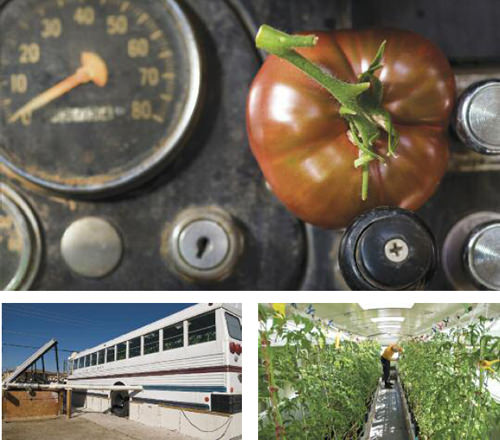edible notables
ON THE MOVE
Tomatoes thrive in hydroponic grow bus.
WRITTEN BY MARNIE MCARTHUR
PHOTOS BY CANDICE NYANDO
For years, urban farmers have cracked concrete and moved earth to grow vegetables on vacant lots and high-rise rooftops. In Reno, creative minds have experimented with urban farming in a special location: an old bus transformed into a solar-powered, hydroponic greenhouse.
Hydroponics is not a new idea. But 90 heirloom tomato plants with 20-foot-long vines robustly growing year-round in a converted bus certainly is. Meet BusAqua, which rests at the entrance to Urban Roots Farm on West Fourth Street in Reno.
“The bus is an exceptional teaching tool,” says Jeff Bryant, executive director of Urban Roots.
At Urban Roots, the goal is to inspire children and adults to imagine what they can do in their own yards and schoolyards.
“It was an obsessive project,” admits Mark Hubert, the modest mind behind BusAqua. “But it isn’t about me; it’s for the community. It’s serendipitous how an old bus, a community food project, and Urban Roots came together.”
How It All Began
The creation of BusAqua began in a backyard near the Reno-Tahoe International Airport. It was inspired by Hubert’s friendship with Gino and Juli Scala, who own Pathways Café and Great Full Gardens Café in Reno and grow heirloom tomatoes for their own restaurants.
“I wanted to do the same thing using less fossil fuel,” Hubert says.
The Scalas agreed to buy his tomatoes if he succeeded. He did.
Following a class in aquaponics, Hubert became hooked on this method. In the end, he chose hydroponics because “there aren’t enough fish in Reno!”
Both growing methods are closed systems with plant roots suspended in water, where they receive essential nutrients. In aquaponics, the nutrients come from fish; in hydroponics, from a solution of nitrogen, potassium, phosphorus, and many trace minerals.
Growing Bus
The plants in BusAqua grow in buckets filled with fired clay balls to stabilize the roots. Solar panels supply energy to heat a reservoir of nutrient-rich water, which is pumped via tubes through the buckets and returned to the reservoir by gravity. Plexiglas skylights admit natural light, and solar-powered light tubes are on 14 hours a day. The daytime temperature is kept at a minimum of 75 degrees F. A swamp cooler controls humidity, retaining an optimum 85 percent. Hubert says that maintaining the ambient temperature is easy; maintaining humidity is the most difficult part.
“It’s a delicate balance.”
In April, BusAqua was moved from its original location to a permanent home at Urban Roots Farm. To arrange a tour, call 775-636-5105. Learn more about Urban Roots Garden Classrooms and volunteer opportunities, at http://www.Urgc.org.
Freelance writer Marnie McArthur loves the heirloom tomatoes she buys at farmers’ markets. Armed with new knowledge, she would now consider growing her own.


